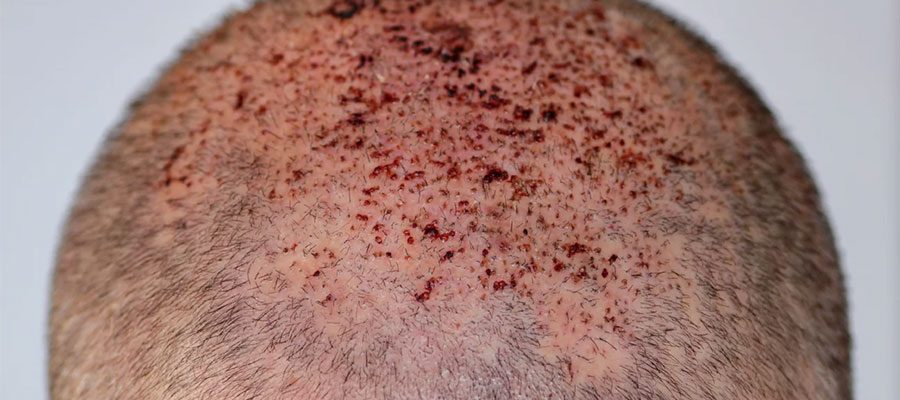Hair transplants are used to thicken or replace hair in areas of the head that are sparse or receding. It involves transplanting hair from fuller sections of the head or other areas of the person to the decreasing or balding area of the scalp. Briefly defined, a hair transplant is a procedure that removes your existing hair and transplants it to an area where you don’t have any. It’s usually obtained from the rear of your head, although other regions of your body might also be used.
The medicines you were given before the operation may have an effect on you for up to 24 hours thereafter. Drowsiness, vertigo, confusion, sickness, vomiting, or hyperpigmentation of the treated region are all possible side effects. If you experience any of these symptoms, doctors recommend having an adult partner stay with you for the next 24 hours.
Your doctor sanitizes the region where the hairs will be taken and desensitize it with a local anesthetic prior to beginning the transplant. If you wish to relax through the procedure, you also can request assistance.
Your surgeon gently eliminates any tapes when the procedure is completed. Because the region may be inflamed, your doctor may administer triamcinolone to reduce the puffiness. You’ll probably experience discomfort or discomfort at the transplant location as well as the place where the hair was removed. Scarring is the most common side effect, and there is no way to totally eradicate it. The following are some other possible adverse effects:
- • There could be an infectious outer layer or fluid flow at the operation sites.
- Inflammation of hair follicles causes scalp discomfort, stinging, and edema
- Bruising, numbness, and tingling around the surgery sites
- Noticeable sections of hair that do not fit the overall hair or are clearly weaker starting to lose hair if your hair is still receding
It’s unlikely, but not improbable, that you’ll have displaced part of your grafts by vomiting, based on how forcefully you puke. You’re generally fine if you do not even observe any of your grafts extending higher than they had been before you were unwell, or transplants that have fallen out. If you’re worried, you can have your surgeon examine the region.
There are various methods for controlling or alleviating nausea; nevertheless, if these methods do not appear to help, consult your doctor.
If you can’t seem to get rid of your nausea, consider the following:
- Drink only clear or ice-cold beverages.
- Light, basic foods, such as saltine crisps or plain baguette, should indeed be taken.
- Slowly sip your drinks.
- After eating, do not engage in any physical activity.
- After eating, avoid cleaning your teeth.
- Fried, greasy, and sugary foods should be avoided at all costs.
- Swallow your food gently and eat lighter, more frequent portions.
- It is not advisable to combine hot and cold meals.
- To acquire enough nutrients, eat items from all dietary categories as much as you can handle.
Table of Contents
Upon vomiting, what should you actually consume?
Banana, grains, apple, dry bread, and carbonated biscuits are all good options. Avoid items that might aggravate or be hard to digest for 24 to 48 hours after the previous occurrence of vomiting, such as wine, coffee, oily, salty foods, dairy, or cheeses.
All in all, there are various risks associated with each medical operation. Patients should conduct thorough research before undergoing a hair transplant to determine which choice is the most practical for them. If the risks overpower the benefits, it is far safer and better to let things happen naturally rather than go through an awful experience.
What can damage hair grafts?
Hair grafts are fragile and can be easily damaged in the days and weeks following a hair transplant. Some common activities that can damage hair grafts include:
- Touching or rubbing the scalp: This can dislodge or damage newly transplanted hair grafts, and increase the risk of infection.
- Sleeping on your side or stomach: This can put pressure on the scalp and increase the risk of dislodging hair grafts.
- Wearing tight hats or headbands: This can put pressure on the scalp and damage hair grafts.
- Excessive sweating: This can increase the risk of infection and damage hair grafts.
- Swimming or submerging the head in water: This can increase the risk of infection and dislodge hair grafts.
It is important to follow all post-operative instructions provided by your healthcare provider to ensure optimal healing and to avoid activities that may damage hair grafts.
How Do You Know If You Have An Infection After Hair Transplant?
This is one of the most often asked questions, yet determining whether you have an infection or not is simple. Excessive redness and swelling, generally accompanied by redness and discomfort, are telltale indicators of infection after hair transplant surgery. Bleeding can also happen because of an infection. In general, this means that the negative effects of hair restoration surgery worsen rather than improve after a week. If you have a problem, you should contact the doctor with whom you worked. This is not a game; your health and appearance are at stake.
Reference:
https://www.healthline.com/health/infected-hair-transplant

